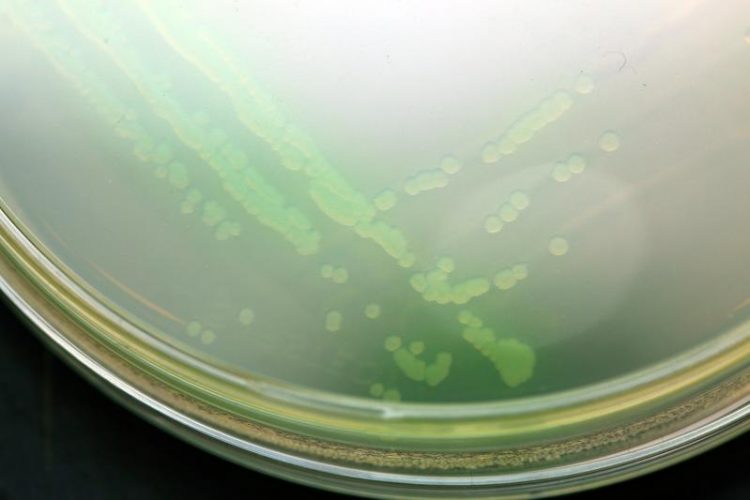New strategy for fighting antibiotic-resistant pathogens

Pseudomonas aeruginosa colonies grow in a petri dish, Pyocyanin makes them appear in a light green colour. Photo: Christian Urban, Kiel University.
Recent research by a group of scientists at Kiel University has shown that there are possible ways to prolong the effectiveness of the antibiotics that are currently available.
Rapid evolution of resistance to antibiotics represents an increasingly dramatic risk for public health. In fewer than 20 years from now, antibiotic-resistant pathogens could become one of the most frequent causes of unnatural deaths.
Medicine is therefore facing the particular challenge of continuing to ensure the successful treatment of bacterial infections – despite an ever-shrinking spectrum of effective antibiotics. Recent research by a group of scientists at Kiel University has now shown that there are possible ways to prolong the effectiveness of the antibiotics that are currently available.
The team, headed by Professor Hinrich Schulenburg and Dr. Gunther Jansen from the Evolutionary Ecology and Genetics research group at Kiel University, investigated the effects of daily switching of two pairs of antibiotics that are common in clinical practice against Pseudomonas aeruginosa. This bacterium is a common disease agent, often multi-resistant and can cause life-threatening infections in immunodeficient or chronically ill patients.
For the current study, evolution experiments were carried out under controlled laboratory conditions. In doing so, a series of quick switches between the two antibiotics, known as antibiotic cycling, proved highly effective against the pathogen. At the same time, it also inhibited the bacteria's ability to evolve resistance against the drugs. The research group has now published these findings in the current issue of the journal Evolutionary Applications.
Although antibiotic cycling is already widely used in regular medical treatment, antibiotics are usually only switched after several weeks. These time intervals are likely too long. Bacteria are capable of evolving resistance within just a few days – sometimes even within hours. In the evolution experiments, therefore, the scientists now switched clinically relevant antibiotics every 12 hours and compared this treatment to corresponding monotherapies, where a single antibiotic was administered continually.
Quick switching proved particularly effective. “We were surprised that we were able to eliminate bacterial populations in our experiments, despite using non-lethal doses of antibiotics. A temporally complex environment, such as the one created by quickly switching between various antibiotics, seems to overtax the bacterium's ability to evolve any kind of resistance mechanism”, says Schulenburg, member of the research focus “Kiel Life Science”.
These recent findings by the research group in Kiel therefore indicate a promising alternative approach to conventional use of antibiotics. Their approach has a different rationale and may help to combat the increasingly menacing antibiotics crisis. The focus here is on evolution, and therefore the ability of pathogens to adapt to the antibiotics. “Developing new antibiotic drugs will not be able to keep up with the speed at which pathogens evolve to resist new treatments. Our approach thus aims to apply existing substances more usefully”, says Roderich Römhild, lead author of the study.
Further research projects are currently in preparation – paying particular consideration to everyday clinical situations. The available results are part of the Evolutionary Ecology and Genetics research group's ongoing research on pathogen adaptation, which is a central topic within the new research focus “Kiel Life Science” at Kiel University.
Original publication:
Roderich Römhild, Camilo Barbosa, Robert E. Beardmore, Gunther Jansen and Hinrich Schulenburg (2015): Temporal variation in antibiotic environments slows down resistance evolution in pathogenic Pseudomonas aeruginosa. Evolutionary Applications
Link: http://dx.doi.org/10.1111/eva.12330
Contact:
Prof. Hinrich Schulenburg
Department of Evolutionary Ecology and Genetics,
Zoological Institute, Kiel University
Tel: +49 (0) 431-880-4141
Email: hschulenburg@zoologie.uni-kiel.de
More information:
Department of Evolutionary Ecology and Genetics, Zoological Institute, CAU Kiel
http://www.uni-kiel.de/zoologie/evoecogen
Research focus “Kiel Life Science“, Kiel University
http://www.kls.uni-kiel.de
Media Contact
All latest news from the category: Life Sciences and Chemistry
Articles and reports from the Life Sciences and chemistry area deal with applied and basic research into modern biology, chemistry and human medicine.
Valuable information can be found on a range of life sciences fields including bacteriology, biochemistry, bionics, bioinformatics, biophysics, biotechnology, genetics, geobotany, human biology, marine biology, microbiology, molecular biology, cellular biology, zoology, bioinorganic chemistry, microchemistry and environmental chemistry.
Newest articles

First-of-its-kind study uses remote sensing to monitor plastic debris in rivers and lakes
Remote sensing creates a cost-effective solution to monitoring plastic pollution. A first-of-its-kind study from researchers at the University of Minnesota Twin Cities shows how remote sensing can help monitor and…

Laser-based artificial neuron mimics nerve cell functions at lightning speed
With a processing speed a billion times faster than nature, chip-based laser neuron could help advance AI tasks such as pattern recognition and sequence prediction. Researchers have developed a laser-based…

Optimising the processing of plastic waste
Just one look in the yellow bin reveals a colourful jumble of different types of plastic. However, the purer and more uniform plastic waste is, the easier it is to…



